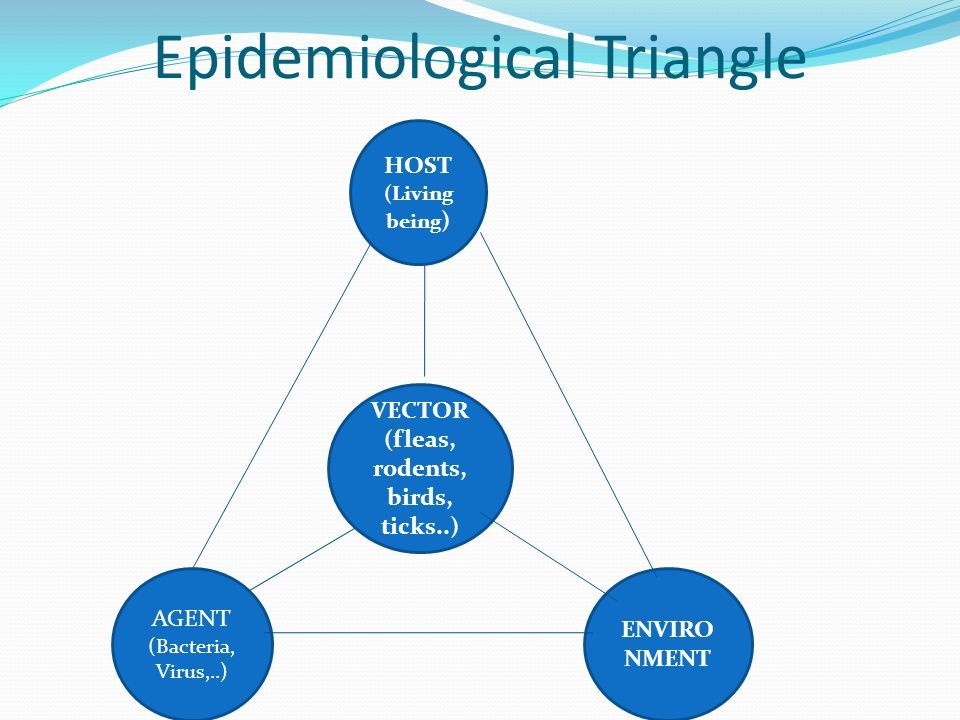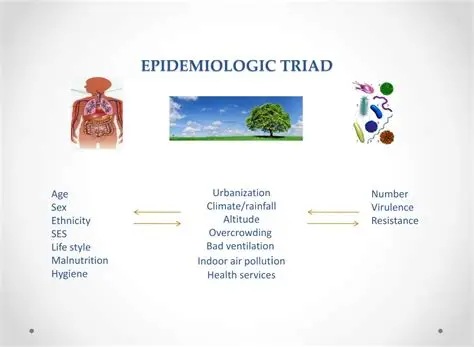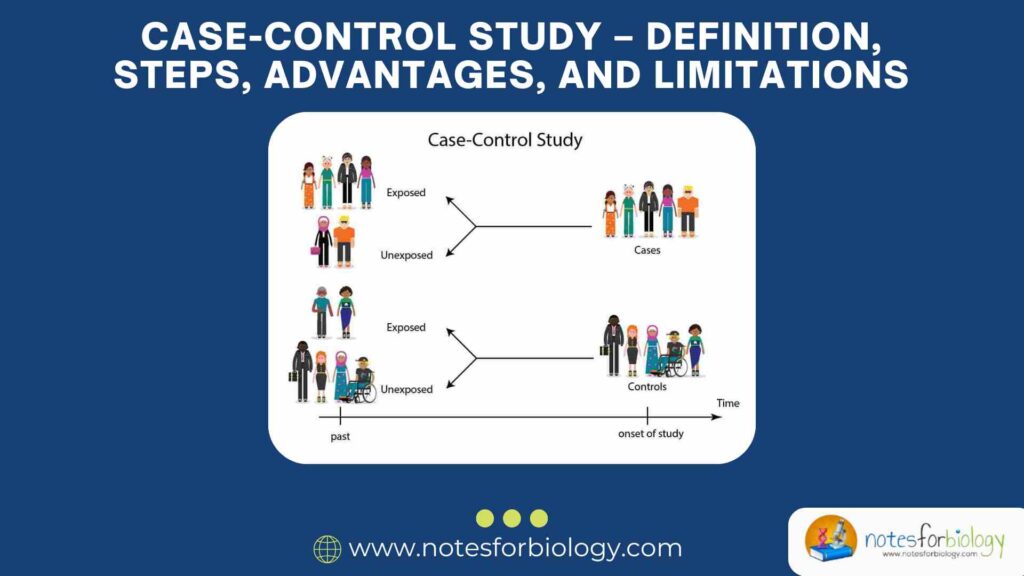Introduction
Understanding how diseases spread, affect populations, and can be controlled is the core focus of epidemiology. One of the simplest and most powerful models used in this field is the epidemiologic triad. This model helps explain how infectious diseases occur and how different factors interact to cause illness. The triad consists of three key components – the agent, the host, and the environment. These three work together like points on a triangle. If any one point changes, the entire disease process can be influenced or even stopped.

Imagine a disease outbreak like a fire. The agent is the spark that starts it, the host is the fuel that keeps it going, and the environment is the oxygen that allows it to spread. Without one of them, the fire cannot continue. In the same way, controlling any part of the triad can help stop or slow down the spread of disease. This simple model helps us see the bigger picture of disease prevention and how we can use different strategies to keep people safe.
In this guide, we will explain each part of the epidemiologic triad in clear and simple language. We’ll also look at examples, the importance of this model in public health, and how it helps in preventing and managing disease outbreaks in both small and large populations.
Table of Contents
What is the Epidemiologic Triad?

The epidemiologic triad is a classic model used by health professionals, scientists, and students to understand the causes of disease and how they spread from one person to another. Epidemiologic Triad shows that a disease can only happen when an agent, a host, and an environment come together in a way that allows transmission and infection to occur successfully.
The three components of Epidemiologic Triad are:
- Agent: The cause of the disease (e.g., bacteria, viruses, toxins). This is the thing that starts the disease process.
- Host: The human or animal that can get the disease. This is the person or animal that gets sick.
- Environment: The surroundings or conditions that allow the disease to be transmitted from one place or person to another.
This model is mainly used for infectious diseases, but it can also be adapted to study chronic diseases, injuries, and even mental health conditions by redefining each component to fit the context of the illness or health problem being studied.
Component 1: The Agent
Definition
An agent is the microorganism or substance that causes disease. It’s like the attacker in the process. Without the agent, no infection or illness can happen. However, just having the agent present is not enough for disease to occur. The agent needs to find a suitable host and a favorable environment to thrive and cause harm.
Types of Agents
- Biological Agents: These are living organisms such as bacteria (e.g., Salmonella), viruses (e.g., HIV), fungi (e.g., Candida), and parasites (e.g., tapeworms) that cause infectious diseases.
- Chemical Agents: These include toxic substances like pesticides, industrial chemicals, pollutants, and drugs that can poison or disrupt body functions.
- Physical Agents: These include physical forces or elements such as heat, cold, radiation, or trauma that can injure or stress the body.
- Nutritional Agents: These involve either a lack of essential nutrients (like iron or vitamins) or excessive intake (like too much sugar or fat) that can lead to illness.
- Mechanical Agents: These are physical forces that cause injury, like sharp objects, repetitive strain, or pressure from tools or equipment.
Characteristics of an Agent
- Infectivity: This is the ability of the agent to enter the host and multiply inside it.
- Pathogenicity: This refers to how likely the agent is to actually cause disease once it infects someone.
- Virulence: This is how severe the disease becomes once the person is infected.
- Toxigenicity: This is the agent’s ability to produce toxins that damage the host.
- Resistance: This is how well the agent can survive outside the host in harsh conditions.
Examples
- Influenza virus causes seasonal flu and spreads easily.
- Mycobacterium tuberculosis causes tuberculosis, especially in crowded places.
- Lead poisoning is caused by a chemical agent that affects the brain and body.
- A sharp knife or injury from a fall can be considered a mechanical agent.
Component 2: The Host
Definition
The host is the organism (usually a human or animal) that can be affected by the disease. This component of Epidemiologic Triad host reacts differently to the same agent. Some people might get very sick, while others may not show any symptoms at all. This depends on their body’s defense system, genetics, habits, and general health.
Factors Affecting Host Susceptibility
- Age: Babies and older adults have weaker immune systems, making them more prone to illness.
- Sex: Men and women may respond differently to some diseases due to biological or hormonal differences.
- Genetic Makeup: Some inherited traits may make people more or less likely to get certain diseases.
- Immune Status: People who are vaccinated or who have had a disease before are more protected.
- Nutrition: A well-nourished body can fight off infections better than one that lacks essential nutrients.
- Behavioral Factors: Habits like smoking, drinking, washing hands, and exercising affect how likely someone is to get sick.
- Chronic Illness: Long-term conditions like diabetes, cancer, or HIV make people more vulnerable to new infections.
Example
- A person who has never had measles and is not vaccinated is at high risk if exposed.
- Children in daycare centers catch colds more often due to constant exposure.
Component 3: The Environment
Definition
The environment is everything outside the host that affects the chances of getting the disease. It includes natural elements, living things, and social factors that help or block disease spread.
Environmental Factors
- Physical Environment: Things like temperature, rainfall, air quality, and geographic location. For example, tropical areas may have more mosquitoes that spread diseases.
- Biological Environment: Includes animals, insects, or plants that may carry or transmit the agent. Rats and mosquitoes are common carriers.
- Socioeconomic Environment: Includes housing conditions, access to clean water, healthcare, education, and income levels. Poor living conditions increase disease risk.
- Cultural Environment: Customs and traditions, such as eating raw food or avoiding vaccines, can affect how diseases spread.
Example
- Dirty water sources can spread diseases like cholera and typhoid.
- Insect bites are more common in areas with little mosquito control.
How the Triad Works Together
A disease outbreak happens when all three components of the triad align in a harmful way:

- The agent must be present and strong enough to cause disease.
- The host must be weak or exposed enough to allow the agent to take hold.
- The environment must make it easy for the agent to move and infect new hosts.
If we change or control any one of these, we can stop the disease. For example:
- Covering water containers breaks the mosquito life cycle and reduces dengue.
- Giving vaccines makes the host immune and prevents illness.
- Cleaning surfaces can kill agents like viruses and bacteria.
Applications in Public Health
The epidemiologic triad helps in many important health activities:
- Identifying causes of disease during outbreaks.
- Designing prevention strategies like vaccination campaigns.
- Improving health education so people understand how to stay safe.
- Targeting interventions to places or people most at risk.
Case Examples
- COVID-19: Agent – SARS-CoV-2 virus, Host – unvaccinated or elderly humans, Environment – indoor areas without airflow.
- Cholera: Agent – Vibrio cholerae bacteria, Host – person with poor immunity, Environment – areas without clean drinking water.
- Obesity (non-infectious): Agent – high-calorie diet and inactivity, Host – someone genetically prone to gain weight, Environment – community with fast food, little space to exercise.
Breaking the Triad: Methods of Prevention
Control the Agent
- Disinfect surfaces and hands regularly.
- Use antibiotics or antivirals to treat infections.
- Vaccinate against preventable diseases like measles or polio.
Protect the Host
- Immunization against deadly diseases.
- Provide healthy food and clean water.
- Educate people on hygiene and healthy living.
- Strengthen immune systems with vitamins and rest.
Modify the Environment
- Build proper sewage systems.
- Use mosquito nets and sprays to control bugs.
- Ensure safe housing and less crowding.
- Provide clean drinking water to all.
Limitations of the Model
While the Epidemiologic Triad is a great starting point, it is not perfect:
- It simplifies complex diseases that may have many causes.
- It doesn’t fully consider social and economic inequalities.
- It was made mainly for infectious diseases, not lifestyle illnesses.
Conclusion
The epidemiologic triad is a foundational concept in public health. It helps explain how diseases occur by showing the interactions between the agent, host, and environment. By studying and adjusting any part of this triangle, we can better understand, prevent, and control diseases. Even though it is a simple model, its applications are vast and powerful when used correctly in both teaching and practice.
In today’s world, where both infectious and chronic diseases are major concerns, the epidemiologic triad remains a valuable tool for health professionals, policymakers, students, and educators who want to protect community health.
Three Key Summary
- The epidemiologic triad includes three parts: the agent (cause), the host (affected person), and the environment (conditions that allow disease spread).
- Epidemiologic Triad is useful for understanding and preventing disease outbreaks, especially infectious diseases that spread through contact, air, water, or vectors.
- By targeting one or more parts of the triad, we can reduce the risk of disease and protect public health with better planning and awareness.
Frequently Asked Questions
What is the epidemiologic triad?
Epidemiologic Triad is a model used in public health to explain how diseases occur and spread, based on the interaction between an agent, host, and environment.
Can it be used for non-infectious diseases?
Yes, by adjusting how we define the agent (e.g., poor diet or stress), Epidemiologic Triad can apply to chronic diseases like heart disease or diabetes.
Why is the environment important in disease spread?
Because it can support or block the transmission of disease agents. Poor sanitation, for example, makes it easier for infections to spread.
Related Articles




